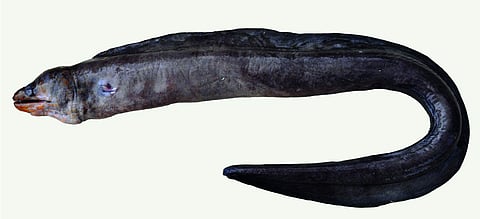

BHUBANESWAR: Odisha is home to one of two rare species of brown short unpatterned moray eels so far discovered in the country. The species spotted along the Bay of Bengal has been christened as Odishi after the name of the State.A team of zoologists has found the Gymnothorax Odishi (locally known as Samudra Kochia) from Gopalpur beach in Ganjam district during a study in January. Moray eels (Muraenidae) are a cosmopolitan family of eels.
Though about 200 species of morays in 15 genera so far recognised worldwide are almost exclusively marine, several species are regularly found in brackish water. Officer-in-Charge of Gopalpur-based Estuarine Biology Regional Centre of Zoological Survey of India (ZSI) Anil Mohapatra said so far, 45 species of moray eels belonging to 10 genera have been recorded from the Indian coast.
“Though nine species of short brown unpatterned species were recognised across the world, only one species - Gymnothorax Mishrai was earlier reported from Indian waters. The eel found at Gopalpur beach is the second such species found in the country. Since it was discovered in Odisha, we have named it Odishi,” he said.
Along with Mohapatra, zoologists Swarup Ranjan Mohanty, David G Smith, Subhrendu Sekhar Mishra and Sanmitra Roy had spotted 11 specimens having length of 420 mm to 700 mm. The specimens were caught close to the coast by hook line operated from the beach within a depth of five metre.“Normally morays display a variety of colour patterns but there are certain morays that display a uniform brown colour pattern. There are two categories of the unpatterned morays found in the Indo-Pacific region. One is short brown unpatterned (less than 150 vertebrae) and long brown unpatterned (more than 150 vertebrae) morays,” Mohapatra said.
When fresh, the body of Gymnothorax Odishi looks brown with yellow patches on upper and lower jaw and portion upto gill. But the yellow patches disappear immediately after preservation leaving only small black patch just behind the eye. When preserved, the body uniformly turns brown and eye ring white.After the study, the holotype and one paratype have been deposited in the Fish Division of ZSI at Kolkata and other nine paratypes deposited in the Museum of Estuarine Biology Regional Centre at Gopalpur. Their study paper has been published in Zootaxa journal. “Since the coast is comparatively not so polluted, we hope some new aquatic species may be discovered in future,” said Mohapatra, who is researching on the diversity of eels.